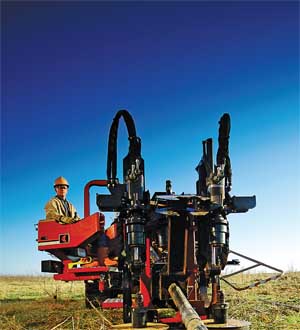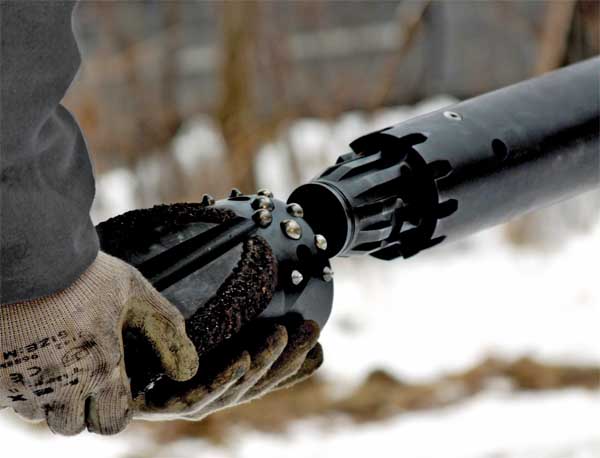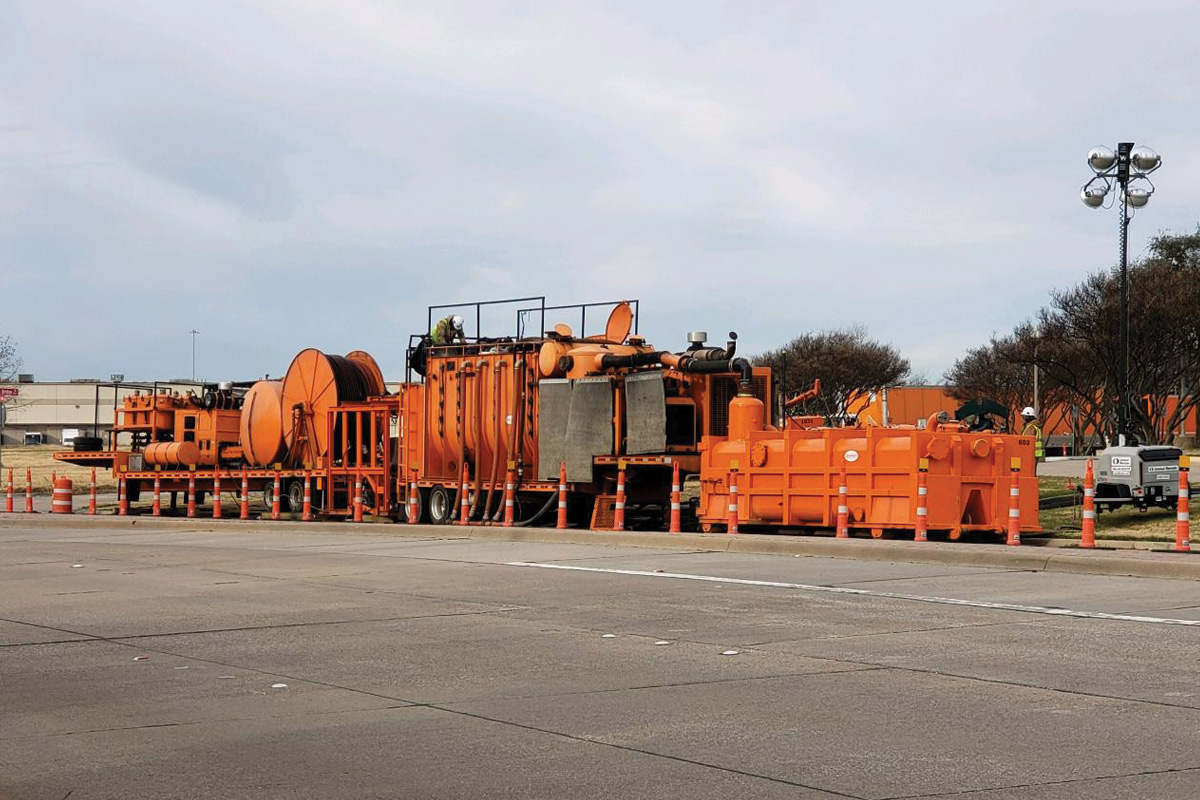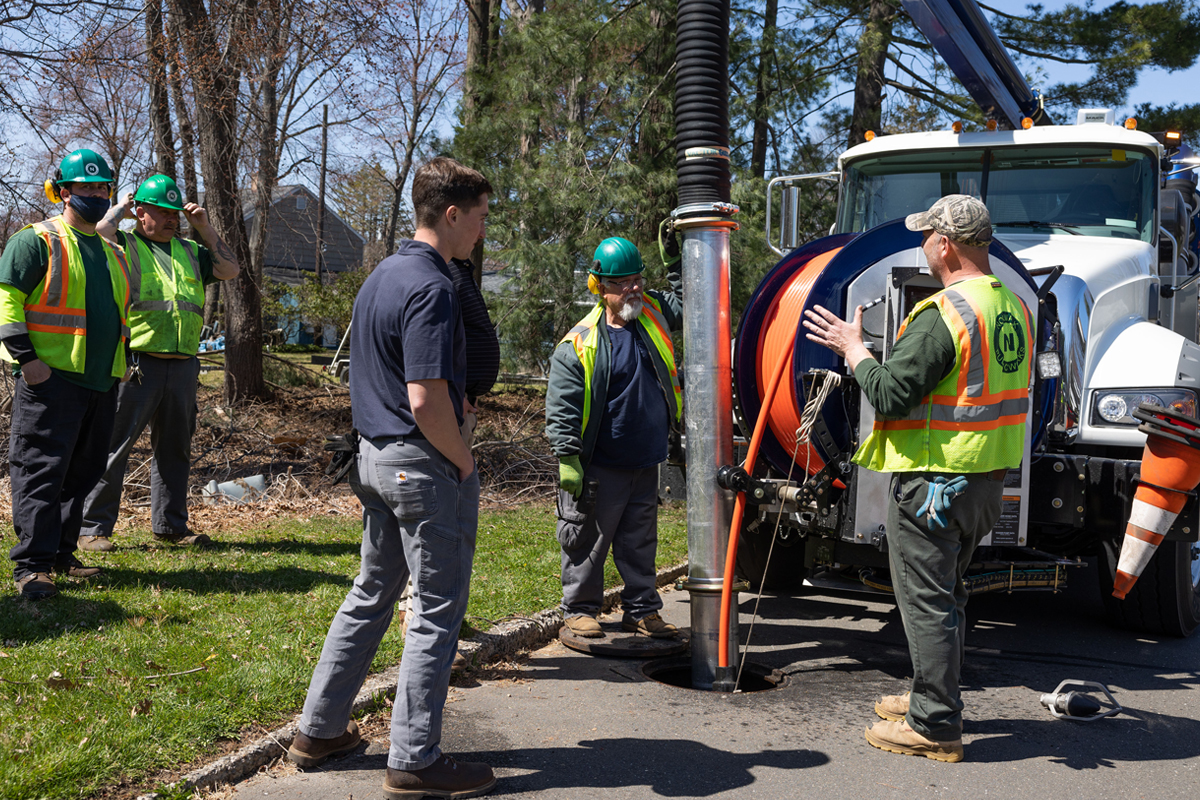Tool Time: What You Need to Drill Rock
In the early 1990s when horizontal directional drilling (HDD) began to be recognized as a viable method for utility construction, rock formations prevented the innovative trenchless construction method from being used on many projects.
The compact drill units developed to install utility pipe and cable often were able to penetrate rock formations, but operators were unable to change the path of the bore head with the slant face downhole tool used on most drill units to steer the pilot bore. Altering the position of the slanted face and pushing the drill string forward causes friction against surrounding soil to change direction of the bore path. The process does not work when the head is in solid rock. HDD technology for machines designed for utility work developed rapidly through the mid-1990s, and rig and tool manufacturers developed bits for drilling in rock.
Some contractors, especially those with oilfield drilling experience, designed their own rock tools.
Adaptations to the slant-face bit worked with varying degrees of success, but through much of the decade the opinion shared by many in the industry was that the only way to directional drill through rock was with a mud motor — a system with a downhole motor driven by drilling fluid. 
In 1995, a 22,500-lb pullback drill unit introduced a mechanical dual pipe system that has been refined and become an effective option for drilling in hard rock with mid-size HDD equipment. Today that system, along with continuing changes to slant-face bits, and the introduction of downhole air hammers for HDD applications provide options for directional drilling in rock. These tools primarily are used for drill units of 100,000 lbs of pullback and less. Mud motors are used with big drill models for rock work for pipelines, long water crossings and other projects to install large-diameter product.
Mud Motors
Downhole mud motors are powered by drilling fluid pumped through the drill string to the motor, which converts fluid flow to rotary speed and torque. Mud motors have been used for drilling in the oil fields since the 1920s, and HDD mud motors are routinely used with large drill units operated by contractors who specialize in long, complex bores, specifically those in rock. In recent years, low-flow mud motors have been developed for directional drilling.
A mud motor is a hydraulic motor attached to a drill string. Drilling fluid powers the motor which drives the drill bit, and the drill string provides steering, direction and rotation. The downhole assembly cannot be sharply steered because of its length and stiffness.
Low efficiency of the mud motor limits available downhole horsepower and requires very high mud flows, more than most small HDD machines can provide. High flow rates and pressures required for effectively driving the bit can erode the borehole and result in frac-outs releasing drilling fluid through the ground’s surface or into a body of water during a water crossing.
Modified Slant-Nose Bits
Slant-nose bits with modified cutting surfaces often are the first option for drillers when they encounter dense, hard soils and rock. Various tool designs are available with replaceable carbide or picks to gouge and scrape the rock or soil. However, the steering is much different than when working in soil. Steering the tool head is accomplished by “carving” the hole by rocking the bit back and forth to cut a ramp in the direction necessary to follow the planned bore path. Depending on soil conditions, production can be extremely slow. This procedure is best performed by a skilled and patient operator. To assist the operator, many drills today offer an automated function to control this process.
Modified slant-nose bits are most effective in hard soils, soils containing rock and very soft rock. These bits are difficult to steer in solid rock. Modified rock bits are widely available in various configurations for small to large drill units and are widely available from numerous HDD downhole tool suppliers.
Downhole Air Hammers
Air hammers recently have come into favor for directional drilling in hard, solid rock formations with compressive strengths up to 25,000 psi. Impact drilling generally is more effective than rotary methods in extremely hard rock. High volumes of compressed air power the hammer. Even higher volumes of air are needed to clear cuttings from the borehole and difficulty in removing spoils often impedes production. Downhole air hammers can be used on single drill stem equipment or dual-pipe models. Steering can be challenging with a single-pipe air hammer using a bent sub and moderately slanted bit. An oscillation- or carve-type cutting action is employed. Newer HDD drills include a feature to help operators be more effective with this technique. Recently dual-pipe rock drilling systems have been equipped to operate air hammers and have proven to be very effective with the bent sub on the outer pipe for steering and the inner pipe providing continual rotation of the air hammer.
Air hammers are not effective in soil and generally are not used for long bores.
Air hammers are very effective for drilling plus-or-minus 6-in. pilot holes in hard rock more than 15,000 psi, and in certain very hard rock exceeding 25,000 psi rock, an air hammer usually is more effective and efficient than other options. Limitations with air hammers include difficulty steering in unconsolidated formations and problems keeping the bore hole clean.
Dual-Pipe Mechanical Systems
Dual-pipe mechanical drive drilling systems allow mid-size HDD models with 30,000 to 100,000 lbs of pullback to effectively drill in rock that is beyond the capability of conventional machines with comparable pullback ratings. The mechanical motor system has an inner rod that drives the rock bit, and an outer pipe to provide steering. Unlike mud motor systems, the tracking electronics of a mechanical system is at the drill head, not 10 or 15 ft behind it as on similar size mud motor. The mechanical system delivers maximum power to the drill bit and enables simultaneous drilling and steering through rock and rocky soils while using no more drilling fluid than conventional equipment.
In addition to rock, mechanical systems are effective in dirt and most other types of soil. If other soils are encountered during a rock bore, the machine can bore through them. Loose cobble is one of the most troublesome soils for directional drilling because directional changes are extremely difficult, and dual-pipe systems often are the most effective choice for making an installation in cobble.
A HDD machine equipped with the mechanical system means that the presence of rock does not prevent the use of directional drilling on many projects that once were considered impossible to drill. Mechanical rock systems currently are available from two manufacturers, and the products they offer have significant differences.
Planning and Preparation
Successful directional drilling in rock is not a matter of simply switching to a rock tool and proceeding routinely. Horizontal directional drilling in rock requires planning, the right equipment, patience and persistence.
Drilling organizations with a job containing rock must plan carefully, considering rock structure and rock hardness. Rock that appears to be soft may in fact be hard, and rock that appears to be hard may be soft. Soft rock can be highly abrasive, quickly wearing down downhole tools. Formations can change from soft to hard and back again and with segments of the bore path being rock free.
Lack of preparation is an invitation to failure. Soil tests should confirm types of rock before a job is bid. Success depends on selecting the correct method of drilling and using the right tools and drilling fluid.
Drilling in rock is not for novices. Experienced operators understand they have to proceed slowly and carefully and not attempt to take shortcuts. Indeed, some believe consistently completing successful rock bores is an art.
Rock drilling is not for every contractor. Depending on the requirements of a project and the types and hardnesses of rock, many wisely subcontract the work to a rock drilling specialist who has the equipment and experienced operators to do the job.
For all the challenges rock presents, the solutions described in this report make HDD an all-soils method of trenchless construction. Early shortcomings and limitations have been replaced by technologies that have broadened the effectiveness of mid-size HDD systems even in difficult conditions. Drillers today have multiple choices to allow them to be successful in what used to be impossible.
Richard Levings is a senior product manager with Ditch Witch, based in Perry, Okla.





